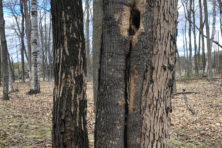Timeline of Lake Michigan Invasive Species
- Share
- Tweet
- Pin
- Share
Since the 1800s, more than 180 non-indigenous aquatic species from around the world have established in the Lake Michigan ecosystem. The ones named – including humans –have become well established and present a high ecological and economic impact on the ecosystem.
In addition, pollution, fish stocking, and invasive species control efforts have led to dramatic changes in the Lake Michigan ecosystem.
1854: C.P. Richmond builds the first paper mill on the Fox River, which was the start of more than a hundred years of dumping toxic papermaking chemicals into the Fox, which flows north into Green Bay.
1890s: Common carp arrive in Green Bay
1920s: Rainbow smelt arrive in Green Bay
1930s: Sea Lamprey arrive in Lake Michigan
1946: Wide use of DDT in pesticides begins throughout the United States
1950s: Alewife arrive in Green Bay
June 26, 1959: St. Lawrence Seaway is opened, linking the Great Lakes region to global markets – and invasive species carried by ocean-going vessels.
1960s: Eurasian Water Milfoil arrive in Lake Michigan
1962: Rachel Carson publishes Silent Spring, alerting people to the dangers of DDT
1966: Michigan DNR begins stocking salmon to create a sport fishery in Lake Michigan
1970: Clean Air Act is passed, limiting air pollution
1971: Fox River sediment is found to contain high levels of cancer-causing polychlorinated biphenyls (PCBs). The Wisconsin DNR initiates a study to find the source of the contamination. Monsanto, the producer of the PCBs, began requiring its customers (such as Fox River paper mills that used PCBs as a coating in carbonless paper) to sign waivers relieving Monsanto of financial liability for improper uses of the chemical, thus putting buyers on notice of possible dangers.
1970s: Purple Loosestrife arrive around Lake Michigan
1972: Clean Water Act is passed, beginning strict limitations on industrial discharges into rivers and lakes
1972: DDT is banned from agricultural use
1976: DNR releases report on Fox River PCB contamination. Fish consumption advisories are issued for the first time.
1977: The manufacture of PCBs is stopped.
1987: Spiny Water Flea arrive in Green Bay
1988: White Perch arrives in Green Bay
1991: Zebra Mussel arrives in Green Bay
1998: Round Goby arrives in Green Bay
1998: The Environmental Protection Agency declares the Fox River a Superfund site due to PCB contamination and seven paper companies are identified as being responsible for the contamination.
1999: Fishhook Water Flea arrives in Lake Michigan
2002: Eurasian Ruffe arrives in Green Bay
2003: Quagga Mussel arrives in Green Bay
2007: Bloody Red Shrimp arrives in Green Bay
2008: Chub population in Lake Michigan crashes
2014: $56 million settlement reached between authorities and eight parties to help pay for Fox River Cleanup
20??: Asian carp arrive in Lake Michigan

